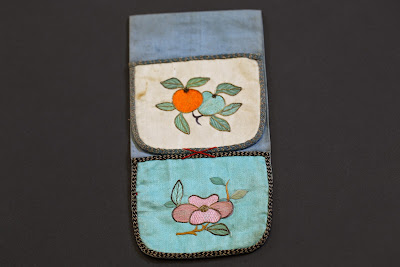Han Chinese women of the upper class were binding their feet for more than a thousand years. This method resulted in small and deformed shape. A woman with bound feet could not engage in hard labor, so had to be of high status and wealthy.
The Manchus, which conquered China in the 17th century and ruled as the Qing dynasty, forbade their women to bind their feet. However wearing elevated shoes made the wearer walk in small steps characteristic of women with bound feet and when worn with long skirts the wearer appeared as though having bound feet.
Elevated shoes also made Manchu women tower over the subjugated Han Chinese. The pedestal were usually cover in white cloth so it could easily be whitened again.
This pair of Manchu platform shoes is of 19th century, decorated with flowers and butterflies, all executed in silk using couching technique, French knot and applique.
The Manchus, which conquered China in the 17th century and ruled as the Qing dynasty, forbade their women to bind their feet. However wearing elevated shoes made the wearer walk in small steps characteristic of women with bound feet and when worn with long skirts the wearer appeared as though having bound feet.
Elevated shoes also made Manchu women tower over the subjugated Han Chinese. The pedestal were usually cover in white cloth so it could easily be whitened again.
This pair of Manchu platform shoes is of 19th century, decorated with flowers and butterflies, all executed in silk using couching technique, French knot and applique.







































